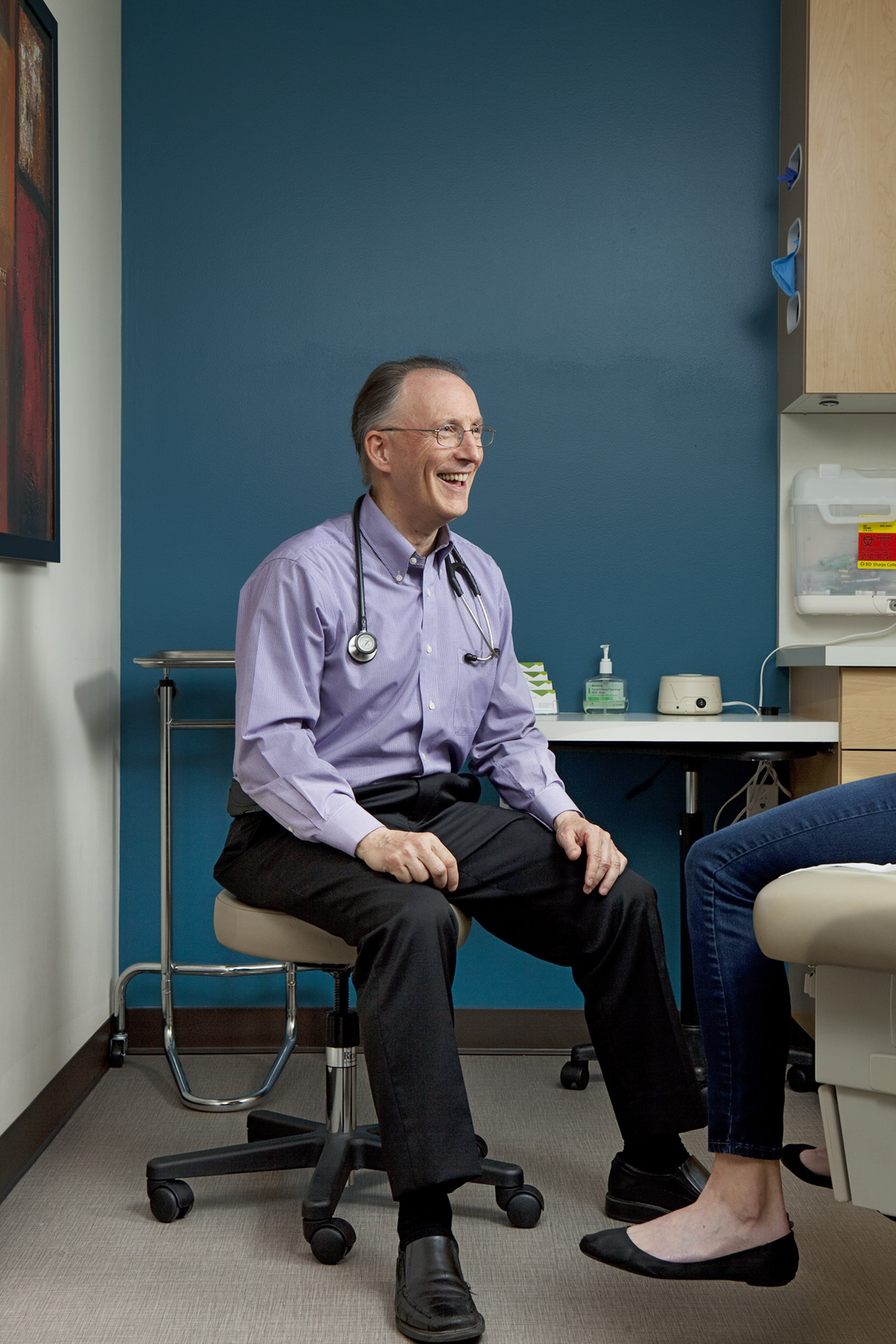
Nowhere outside the pages of Dickens is there a more aptly named fellow than Garrison Bliss. A trim, gray man, he has twinkling eyes and a face lit by a smile of such authenticity that it makes you think of Shaker furniture. But he’s a doctor, not a mystic. And he’s smiling because he believes he and his cousin have found the answer to one of the toughest questions in health care.
The idea is deceptively simple: Pay frontline doctors a fixed monthly fee directly instead of through the byzantine insurance bureaucracy. Make the patient, rather than the paperwork, the focus of the doctor’s day. The result will be happier doctors, healthier patients and a striking reduction in wasted expense.
In one of the more intriguing experiments in the medical industry, Qliance Health, the company Bliss co-founded with his cousin Dr. Erika Bliss, 47, is applying this idea to managing the health of roughly 35,000 patients–about half of them on Medicaid. If it can work for them in Seattle, they say, maybe it could work for everyone.
How the Bliss cousins arrived at this notion is a more complicated story. But it’s one worth telling, because it says a lot about how the U.S.–normally adept at hooking up the buyers and sellers of goods and services–managed to make such a mess of its medical economy. The story starts with the fact that Garrison Bliss, 69, wasn’t always so happy.
He is a primary-care physician, and a career in primary care has become a recipe for misery in the U.S. Nearly a third of all frontline physicians ages 35 to 49 expect to quit within the next five years, according to a 2012 survey by the Urban Institute. Young healers who start with dreams of being Marcus Welby often sour when they meet the realities of the job–which can include seeing patients every 11 minutes and having their performance assessed by how many MRIs they order.
Like so many others in his field, Bliss came to feel that he wasn’t in the business of caring for patients at all. His job was to feed payment codes into the grinding machinery of the insurance companies, rushing from exam room to exam room, ordering tests, making referrals, scheduling follow-up visits in which the cycle would be repeated. He knew that a proper exam, with time for counseling and questions, can take 45 minutes or more. Yet even a 15-minute session became a luxury.
“There are no insurance codes for ‘cure,'” Bliss likes to say.
One day about 20 years ago, two of Bliss’s colleagues announced that they were stepping off the treadmill to create a new kind of practice. They invited a small number of their wealthiest patients to become members of a premium health care group. For a five-figure annual fee, those patients would have immediate access to the doctors. They would be able to schedule appointments on short notice and would never again languish in a waiting room. Should they need to see a specialist, their primary-care doctor would be happy to accompany them as an advocate and translator. This model, which was soon emulated by upscale doctors across the country, came to be called concierge medicine.
Coddling the rich was not Bliss’s bliss. Still, he was intrigued. Could the same idea work at a more affordable price? What if, instead of charging $1,000 per month for each membership, he charged $65? He didn’t have to decorate his clinic like a Canyon Ranch spa or set up shop on Seattle’s most expensive real estate. If he brought down the overhead, would ordinary people pay the equivalent of a monthly cable bill for the satisfaction of having a doctor who knew their histories and cheerfully answered their questions?
Bliss launched an affordable primary-care practice, called Seattle Medical Associates, in 1997–and soon had all the patients he could handle. At last, he was working for them. And he was happy.
Considering the health care model Americans are accustomed to, it can be hard to get your head around the approach Bliss had come to call direct primary care. But here’s how it works: for a flat fee every month, patients have unlimited access to their doctor–in person and by phone or email–for routine things like checkups, cuts and burns, infections, flu shots and skin exams, as well as chronic-condition maintenance like blood tests for diabetes or high cholesterol. Under the law, every American is required to have medical insurance–but direct-primary-care patients can seek less expensive policies, because they require coverage only for hospitalizations, surgeries and other specialized care.
It was working for Bliss, so when he heard that his cousin Erika was miserable after just three years in primary care (“burned out, cooked, feeling like a failure and thinking about getting out,” as she puts it), he shared some of his sunshine with her. “Every time I walk into the examination room, I feel like I’m going to a party!” he sang over the phone. “I think this model I’ve been doing has a lot of potential to change health care for the better. Come help me scale it up.”
Since then, they’ve signed up previously undreamed-of populations: big private employers like Expedia and Comcast, public and industry employee unions like the one for Seattle firefighters and–most radical of all–at least 15,000 Medicaid patients.
The private company’s results so far suggest that the model is scaling up nicely. Qliance now serves some 35,000 patients; the cost of about half of them is paid by the government through traditional and expanded Medicaid programs. Treating a wide variety of patients–young and old, healthy and chronically sick, well-off and poor–Qliance claims to be saving approximately 20% on the average cost of care compared with traditional fee-for-service providers. The company’s staff has tripled over the past year, and Qliance is looking to expand beyond Washington.
Unhappy primary-care docs from across the country are streaming to Seattle to find out if some version of Qliance could be their salvation. The American Academy of Family Physicians, which kept concierge medicine at arm’s length for years, is moving quickly to embrace the direct-care concept. And the promise of greater efficiency and better results has attracted the likes of Amazon’s Jeff Bezos and his fellow billionaire Michael Dell to invest in Qliance.
All of which makes Bliss smile.
A NEW MODEL
Concierge care was originally conceived before Obamacare, and it revved up in response to the Great Recession as an escape hatch for doctors fleeing the status quo. The existing fee-for-service system pays caregivers a certain amount for each test, diagnosis and procedure–which, according to critics, encourages overtreatment instead of preventive wellness care. Qliance, along with a growing number of similar operations, aims to be more than an escape. It seeks to be the answer to the quest of health care reformers: healthier patients at a lower cost. Fix the way primary-care doctors are paid, the Blisses argue, and we can cut unneeded tests, premature procedures and excessive ER visits.
The driving insight here is that primary care and specialized care have two very different missions. Americans need more of the first so they’ll need less of the second. And each requires a different business model. Primary care should be paid for directly, because that’s the easiest and most efficient way to purchase a service that everyone should be buying and using. By contrast, specialty care and hospitalizations–which would be covered by traditional insurance–are expenses we all prefer to avoid. Car insurance doesn’t cover oil changes, and homeowners’ insurance doesn’t cover house paint. So why should insurance pay for your annual checkup or your kid’s strep swab?
When people get good primary care, their maladies are diagnosed more quickly and can be managed before they grow into crises. Fewer patients wind up in expensive hospital beds. Emergency rooms treat genuine emergencies, not routine infections and minor injuries. Patients receive timely advice and encouragement from a trusted physician to shed those pounds, change that diet, drink a little less and exercise more. The fee-for-service insurance model discourages this approach. It pays mainly for treating disease, not preventing it. Worse, it makes the life of a primary caregiver so exhausting that students in medical schools and nursing schools are avoiding the field altogether. According to Colin West, a co-director of the Mayo Clinic’s program on physician well-being, the U.S. faces a shortage of tens of thousands of primary-care doctors–at a moment when we need them more than ever. In a definitive survey of third-year med students published in the Journal of the American Medical Association, he found that only about 20% were headed into primary care.
West was particularly dismayed by the number of students who started medical school with primary care as their ideal but gave up by year three. They had figured out, he explains, that the burdens of our health care system “roll downhill to the primary caregivers.” To make up for unpaid time spent filling out forms, docs must see more patients to generate more payment codes.
At the tangled heart of this dysfunction is Medicare, which by its sheer size sets the standards for insurance reimbursements. Specialists dominate the panel that sets its payment rates. Thus the system values surgeries, scans and other procedures more than it values checkups and management of existing conditions. West, a primary-care doc, explains it this way: “If I put in an hour with a patient, I will be reimbursed for one exam–the same payment I would get for seeing that patient for 11 minutes.
“Meanwhile, an ophthalmologist might perform three cataract surgeries in that same hour, and each surgery might be reimbursed at twice the rate of my exam. So that doctor is making six times as much money.”
And if the eye patient has questions after the surgery about her medicine or her recovery, the specialist’s office is likely to suggest that she consult with her primary caregiver. After all, neither doctor gets reimbursed for answering questions on the phone, so the chore is often traded like a hot potato. “We say primary care is critical to a healthier future,” West says, “but in every way we show value, it is at the lowest level.”
DIRECT ACTION, IN ACTION
On a rare crystal day in Seattle, I paid a visit to the headquarters of the online travel agent Expedia. For over a year, Expedia has paid Qliance a fixed per-patient fee to provide a direct-primary-care option for HQ workers. Specialists and hospitalization are covered by traditional insurance.
Expedia was motivated to try direct care for reasons that are familiar to business executives everywhere: health care bills were skyrocketing, but employees were not getting healthier. “We had a number of catastrophic illnesses in 2011 and a disturbing number of deaths–12,” vice president for human resources Connie Symes tells me. “We found Qliance and their model of spending quality time with patients addressed our need to get employees involved in their own care.”
Qliance opened a clinic in Expedia’s building. The clinic is staffed by three doctors and includes several exam rooms, a small lab to perform routine tests, an X-ray machine and a stock of commonly prescribed generic medicines. Expedia employees zip from their desks to the doctor’s office with little or no waiting time. New patients spend 45 minutes elaborating their medical histories; after that, most visits can be handled in 15 to 30 minutes. Patients can also reach their doctors by text and email.
At the end of last year, Expedia surveyed the staff, Symes says, and the response was emphatic. More than half the employees had tried Qliance, and of those, more than 95% said they were satisfied. “They love the doctors,” Symes says. “They love the personal relationships they’re forming.” And although Expedia still classifies Qliance as an experiment, Symes says direct primary care, with its emphasis on prevention, “is taking us in the right direction on lowering costs.”
Seems too good to be true, I tell Erika Bliss, Qliance’s CEO, and she replies that she hears that a lot–but that’s because we haven’t seen, from the inside, how much waste and inefficiency is larded into the existing system. With enough freedom, she says, a primary caregiver can easily find lots of ways to deliver superior health care at a lower price. Bliss suggests that proper primary care should cost an average of about $1,200 per patient per year and will save significantly more than that in emergency care, specialist visits and treatment of chronic diseases.
“The existing system is built around diagnosing and treating complex cases. It rewards expensive, invasive and complicated solutions. But patients don’t want to be complex cases,” Bliss says. She cites a famous study by the Institute of Medicine that estimated that 30% of each health care dollar is wasted in the U.S. While reformers struggle to “bend the curve” of rising costs by squeezing out the waste, “we just lop it off,” she says.
While the results at Expedia are intriguing, the real test of direct primary care began when Qliance became the first practice of its kind to join the Medicaid system. Medicaid patients can be a challenging population because many of them have untreated medical conditions after years of inadequate health care. Absorbing thousands into the Qliance practice–at a reported cost to the government of about $700 per person per year–had made for a roller-coaster year. Medicaid patients are promised the same care as other Qliance customers.
One of those new patients is Jim Papadem, an out-of-work printing-press operator in his mid-50s from Redmond, Wash., who had long ignored his deteriorating health out of fear that the cost of treatment would ruin him. “I was pretty sure I had diabetes, and it turns out I had atrial fibrillation too,” he says. At his first meeting with his new Qliance physician, Dr. Randy Leggett, Papadem detailed his many symptoms. Leggett dispatched him to an eye specialist for treatment of a diabetes-related condition. She also prescribed two generic drugs to manage his blood sugar. Next came a referral to a cardiologist to treat the heart malfunction, which Leggett now monitors routinely. “She calls me now and then to check up on me at the end of the day, and when I have questions, she is available to help me connect the dots,” Papadem said.
So where are the cost savings? For Papadem, proper primary care reduces the likelihood of blindness, stroke and heart failure. More immediately, the Qliance patients now have an alternative to getting their care at the local emergency room. According to a 2010 survey of ERs in Washington State, the vast majority of emergency-room complaints are not actual emergencies. Instead, they involve common maladies that are easily handled by primary caregivers. With the average cost of a child’s ER visit running almost $2,000–and the average adult ER visit more than $4,500–Qliance more than pays for itself every time it keeps a client out of the ER.
Qliance’s large, diverse patient group makes it the first direct-care firm in a position to compile compelling statistics on the promise of direct care. “What will tip the scales for us is when we can produce hard data on savings and outcomes,” Bliss says hopefully. That takes some time, but the numbers are firming up. “If we can show that we are getting 15% to 30% of the costs out by using a model that doctors like and patients want, the whole system is going to flip pretty quickly.”
Centene Corp. is a Fortune 500 company hired by Washington State to manage its Medicaid plans. Jay Fathi, CEO of Centene’s Washington affiliate, tells me that “we already have evidence to show us that they are doing a good job.” Confident that the direct-primary-care model has legs, Centene has joined the growing roster of Qliance investors.
SO WHAT’S THE CATCH?
Of course, there’s a catch–at least in the short term. Docs on the treadmill are often responsible for 2,000, 2,500 or even 3,000 patients each. Direct-primary-care doctors serve far fewer patients. In a nation where there is already a shortage of primary caregivers, this would seem to disqualify direct care as a mass solution.
“It’s a trend that will probably grow a bit, but I think there is probably some ceiling to it,” says Ceci Connolly, managing director of the Health Research Institute at consulting giant PwC. Connolly foresees direct care as one part of a wider mix of patient-directed primary-care options, from drugstore clinics and Weight Watchers outlets to wearable monitors and digital apps.
But leaders of the direct-care movement argue that in the longer term, their model can solve the shortage of frontline doctors. By giving primary caregivers a good living doing work they can love, direct care encourages young physicians to follow their heart.
On a recent visit to Wichita, Kans., I met a young doctor who is doing that. Josh Umbehr, 33, was an aspiring primary-care doctor at the University of Kansas when, like many others, he grew horrified by the fee-for-service system. “It was crazy,” he said. “Insurance paid more for a prostate exam if it was done on a separate visit from a checkup. So the patient would have to come in twice. Medicare would pay for cleaning out earwax–but only one ear per visit. You had to schedule a second appointment for the other ear.”
Then he discovered direct care. As the son of a garbage collector, he understood the idea of one price for unlimited service. With classmate Doug Nunamaker, 34, Umbehr launched a moderately priced clinic called Atlas MD. The idea caught on enough that they recently hired a third doctor. Now they care for about 1,800 patients at an average monthly price of about $50 each.
An entrepreneurial dynamo, Umbehr paints a sky’s-the-limit future in which primary care is transformed into medicine’s most valuable role. To hear him tell it, he’s already living that dream, seeing an average of five patients per day–with other interactions by phone, text and email–while earning $200,000 to $240,000 per year. (The national average for primary-care physicians is well below $200,000.)
His in-house pharmacy, run out of a closet, saves patients hundreds of dollars per year on meds–a major selling point for those who blanch at his monthly fee. Take the uninsured mother who could not imagine paying $120 each month to cover herself, her husband and their two kids. Umbehr asked if she was taking any medications, and she said that was the problem: her prescriptions cost $138 per month. Umbehr buys the generic version wholesale for $1.55. “I told her her membership would cover the drugs. We eat the buck and a half as a cost of doing business, and she gets primary care for her family. At the end of each month, she’s 18 bucks ahead.”
When people say this is going to worsen the physician shortage, Umbehr says, “No. The current system is worsening the physician shortage. The ship is already sinking. We probably talk to 10 doctors per week who are burned out, going bankrupt, ready to retire years before they ought to. And when they see they can take better care of their patients and never deal with insurance companies again, and earn $210,000, $220,000, $250,000 per year, you’re going to see physicians flocking.”
Wouldn’t that be something? After so many years of dire forecasts, of blue-ribbon panels and expert commissions, of alphabet agencies and battles on Capitol Hill–wouldn’t it be amazing if the health care revolution finally arrived in the form of simple family doctors offering better care in exchange for a happier life? It’s worth a try, because if it works, an awful lot of people will be wearing that blissful smile.
QUIZ: Should You Eat This or That?
















TO SEE MORE SOLUTIONS GO TO http://www.time.com/solutionsforamerica
Read next: Most Types of Cancer Just ‘Bad Luck,’ Researchers Say
More Must-Reads from TIME
- Breaking Down the 2024 Election Calendar
- How Nayib Bukele’s ‘Iron Fist’ Has Transformed El Salvador
- What if Ultra-Processed Foods Aren’t as Bad as You Think?
- How Ukraine Beat Russia in the Battle of the Black Sea
- Long COVID Looks Different in Kids
- How Project 2025 Would Jeopardize Americans’ Health
- What a $129 Frying Pan Says About America’s Eating Habits
- The 32 Most Anticipated Books of Fall 2024
Contact us at letters@time.com